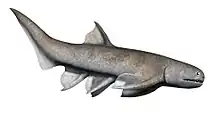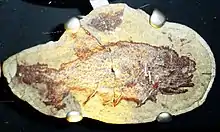Cheiracanthus
Cheiracanthus ("hand spine") is an extinct genus of a group of fish called Acanthodii (or "spiny sharks").[1] It was a deep-bodied acanthodian about 12 in. (30 cm) in length. It had a blunt head, upturned tail, and fins protected by spines. Unlike many other acanthodians, it had one, solitary dorsal fin. Cheiracanthus swam at mid-depth in lakes and rivers, seizing small prey in its gaping jaws. Whole fossils of this fish occur only in Mid-Devonian rocks in Scotland, but its distinctive small, ornamented scales crop up around the world, as far south as Antarctica.

Life restoration of Cheiracanthus murchisoni
| Cheiracanthus Temporal range: Middle Devonian | |
|---|---|
 | |
| Fossil of Cheiracanthus latus at the London Natural History Museum | |
| Scientific classification | |
| Kingdom: | Animalia |
| Phylum: | Chordata |
| Class: | †Acanthodii |
| Genus: | †Cheiracanthus |
| Type species | |
| †Cheiracanthus murchisoni | |
See also
- List of acanthodians
References
- Burrow, C. der Blaauwen, J. Newman, Michael. 2020. Cheiracanthus from Scotland. A redescription of the three longest-known species of the acanthodian Cheiracanthus from the Middle Devonian of Scotland. Paleontologica Electronica. 23(1):a15 https://doi.org/10.26879/1035
This article is issued from Wikipedia. The text is licensed under Creative Commons - Attribution - Sharealike. Additional terms may apply for the media files.